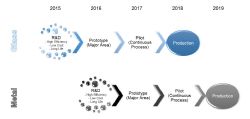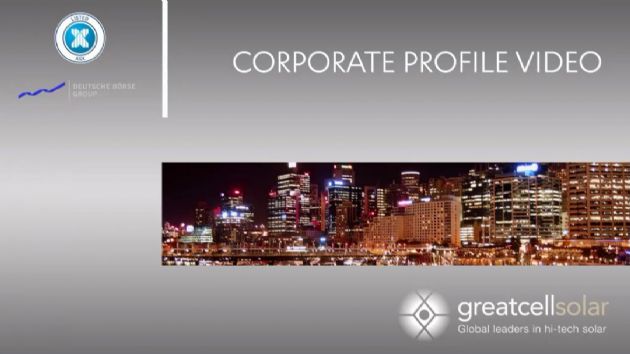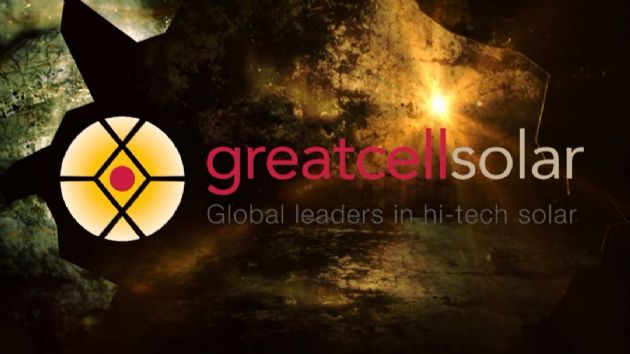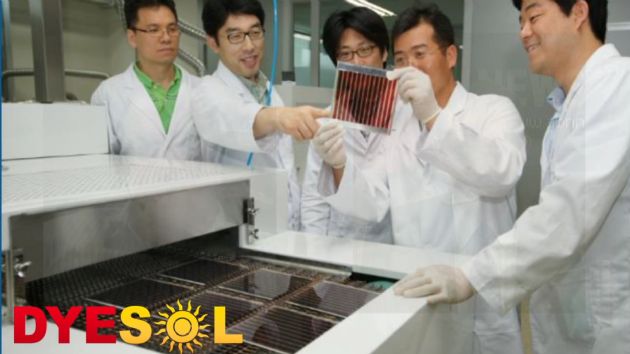 December 2016 Quarterly Report
December 2016 Quarterly Report
Canberra, Jan 31, 2017 AEST (ABN Newswire) - Dyesol Ltd ( ASX:DYE) (
ASX:DYE) ( DYSOY:OTCMKTS) is pleased to provide the Company's Quarterly Report for the period ended 31 December, 2016.
DYSOY:OTCMKTS) is pleased to provide the Company's Quarterly Report for the period ended 31 December, 2016.
- Dyesol Secures a $2.5M Commonwealth Bank R&D Rebate Advance Facility
- Thermal Cycling Technical Advisory Board Milestone Achieved for PSC Strip Cells
- Innovate UK Supports Further Dyesol UK R&D
- Agreement Signed with Flinders University for Advanced Carbon Material Development
- Mini-MAD Prototype Achieves Exciting Scale-Up Progress
Corporate and Financial
Dyesol has accepted the Commonwealth Bank's offer of a $2.5 million R&D Rebate facility. The facility effectively allows us to access government R&D rebates quarterly or in advance of end of year. Previously, rebates have only been accessible after financial year end. We are pleased that our activities and financial management has met with approval during due diligence. CBA appears to have largely replaced the CEFC in this important role in clean energy finance by providing cheaper and more accessible advanced funding. In this respect, the CEFC has paved the way and shouldered the early stage product risk.
Turkish, European and Asian business discussions are all in progress. Nesli DSC in Turkey has recently been reinvigorated with new capital and management, indicating that it will again win the confidence of the Ministry of Science, Industry and Technology after some recent turmoil. There are regular updates to potential JV partners on the progress of the pivotal mini-MAD and MAD projects.
We are also eagerly awaiting news from federal government departments and agencies on a number of pending and significant grant applications. The unexpected delays are industry wide and not confined to Dyesol.
There is plenty of "noise" elsewhere, as highlighted in last quarter's commentary, but we are not surprised to see there has been little subsequent substantiation of some reasonably inflated technology claims. We remain confident that Dyesol is leading the world in the scale-up and industrialisation of this exciting technology. The technical challenge of scale-up is formidable and we will undertake very comprehensive third-party testing and validation at critical stages of development. The data will do the talking, either through CSIRO or Newport Laboratories in the US. In January, Dyesol received a $50,000 Innovation Connections grant to undertake this external validation with the CSIRO in Australia.
Research and Development
Dyesol received a favourable review of progress against its quarterly thermal cycling Technical Advisory Board (TAB) milestone. The work was undertaken in collaboration with CSIRO to stringent IEC 61646 standards and the durability test involved 200 cycles of -40 DEG C to + 85 DEG C for strip cells and modules. This was a demanding test and far exceeds anything likely to be encountered in the real environment. Strip cells achieved a strong pass with less than 10% degradation, and modules failed marginally. The average module performance degradation after 200 thermal cycles from -45 degC to +85 degC was 13%. While this exceeded the 10% test pass criterion, faulty encapsulation was clearly identified as the failure mechanism for modules not meeting the 10% target. This problem has since been isolated and rectified. The TAB provisionally agreed that the progress was significant and compelling, accepting the thermal cycling milestone as passed. Dyesol seeks to excel, and fresh tests are already underway to confirm that the thermal cycling test can be successfully passed with modules for the purposes of IEC 61646 without any qualification.
Dyesol has entered into a R&D collaboration agreement with Flinders University of South Australia. This continues a long historical relationship with some of its senior academic staff. The project builds on promising carbon nanotechnology developed over the last ten years for enhancing conversion efficiency in Dyesol's preferred carbon architecture perovskite solar cells. Dyesol has exclusive use and benefit in relation to all technology developed under the agreed work programme. Of particular interest to Dyesol is the rapid pathway to large volume raw material scale-up using the Flinders' process technology, coupled with Flinders' broad experience in carbon-contacted functional semiconductor devices, including photovoltaic cells, particularly PSC.
Dyesol UK Ltd is being supported by Innovate UK, the UK's technology innovation body, to undertake a funded project aimed at optimising the structure, performance and stability of perovskite solar cells (PSC) through novel interface engineering approaches, in conjunction with its project partner CPI, based in the North of England. The value of the new grant is GBP75,000. The activity is linked closely to that supported by the much larger EPSRC grant of GBP800,000 involving Dyesol UK, Cristal and York University. The project will incorporate several treatments at critical interfaces within the device that are known to constrain solar cell efficiency, and to develop technologies that can be applied to commercially viable manufacturing approaches. Dyesol will apply its fundamental knowledge of device physics and fabrication knowhow to novel processes being developed within CPI with the overall aim of enhancing the performance and stability of its PSC technology.
Alongside the above, Dyesol has also reinforced its contribution to the Solliance collaboration with additional resources specifically allocated towards process development and scale-up for device architectures consisting entirely of inorganic charge transport materials. This approach is essential to ensuring that high durability, high performance devices can be integrated into metal and flexible substrates for Building Integrated PV (BIPV) applications. Forthcoming durability milestones on Dyesol's Technology Development Plan will confirm this approach, and validate its preferred architectures, materials and processes that are developed in Manchester, UK together with its extensive partner network. Initial results are extremely promising and, as detailed below, Dyesol's association with EPFL for pure research, alongside complete access to Solliance's world-class facilities and industrialisation capability will accelerate commercialisation.
Elsewhere, our joint activity with Professor Gratzel at EPFL in Lausanne has achieved conversion efficiencies of greater than 20% using purely inorganic hole transport materials (HTMs), an important development in material architecture over the basic Spiro based system. As presented to Dyesol shareholders by Dr Damion Milliken CTO at the AGM in November, the various all inorganic charge transport material technologies currently under development by Dyesol represent the "Gen 2" technology pipeline. These material sets will facilitate not only opaque substrate devices such as Metal BIPV panels, but also a technology pathway for ongoing product enhancement for glass substrates, including higher efficiency carbon cells and light-transmitting systems for View Glass BIPV applications.
Dyesol was very pleased this quarter that our foundational patent covering use of all inorganic charge transport materials, filed back in 2013, received its first formal jurisdictional grant. This clearly demonstrates the Company's strong intellectual property position, and provides a barrier against competition in the PSC commercialisation space.
Manufacturing and Technical Collaborations
The technology development highlight for the quarter was undoubtedly the showcasing of our early stage prototypes at the November AGM. These are known as mini Major Area Demonstration (MAD) prototypes - 650 mm x 450 mm. Production of the mini-MAD prototypes is an essential step in the scale-up of PSC technology. Moreover, it serves to demonstrate that performance achieved at the strip-cell and module scale can be replicated successfully at a magnitude higher or more. Here we refer principally to efficiency and durability, in its many forms. In addition, cheaper, abundant materials and streamlined fabrication processes are continually being introduced to help span the gap between the laboratory and industrial readiness.
In two areas of meaningful progress during the quarter, the Glass Group has now significantly optimised both larger area coating and scribing. At every step we are methodically addressing critical areas of technical risk and taking steps forward towards mass manufacture.
Phase II of the VDL collaboration is being co-ordinated in lock-step with mini MAD. This is the Design and Engineering phase due for completion at the end of February. While it has run 2 months over time, extra time has been used to identify cheaper equipment suppliers that has helped reduce the MAD budget by approximately 40% to 50%. Unsurprisingly, Asian equipment suppliers have improved significantly in quality in more recent years and are cheaper than their European equivalents. The substitution is particularly valuable for what we describe as non-critical items where performance compromise is negligible. During the quarter, Dyesol also received notification from the Australian Department of Industry approving the Company's Overseas Advance Finding for VDL's inputs to Dyesol's scale-up programme, ensuring positive confirmation for mini MAD, MAD and Pilot costs to be claimed against the R&D Tax Incentive scheme in Australia. This is an excellent financial outcome.
As we launch into prototype development we have had to source additional factory floor space. Fortunately, we have identified a number of possibilities locally. We are very keen to remain clustered in the one precinct where rent is low cost and there is synergy between administration, materials manufacture and prototype development. This will open possibilities for pilot plant development later in the year once the MAD prototype work has been completed. This anticipates taking a MAD 600 mm x 1200 mm panel and automating the process as the penultimate step for mass manufacture.
Financials
The net operating monthly cash burn (Sec. 1.9) for the second quarter averaged $982k excluding the FY 2016 R&D rebate receipt of $3.8m. Net cash usage from operating and investing activities for the six months to 31 December 2016 totalled $1.7m including the R&D rebate.
At the end of the second quarter, cash balances totalled $3m.
Since the end of the quarter, Dyesol has drawn down an initial $1.75m from its CBA advance facility further increasing cash at bank.
To view the quarterly report, please visit:
http://abnnewswire.net/lnk/B4LWK6Q1
About Greatcell Solar Limited
 Greatcell Solar Limited (ASX:GSL) (OTCMKTS:DYSOY) is a global leader in the development and commercialisation of Perovskite Solar Cell (PSC) technology – 3rd Generation photovoltaic technology that can be applied to glass, metal, polymers or cement. Greatcell Solar Limited manufactures and supplies high performance materials and is focussed on the successful commercialisation of PSC photovoltaics. It is a publicly listed company: Australian Securities Exchange ASX (GSL) and German Open Market (D5I). Learn more at our website and subscribe to our mailing list in English and German.
Greatcell Solar Limited (ASX:GSL) (OTCMKTS:DYSOY) is a global leader in the development and commercialisation of Perovskite Solar Cell (PSC) technology – 3rd Generation photovoltaic technology that can be applied to glass, metal, polymers or cement. Greatcell Solar Limited manufactures and supplies high performance materials and is focussed on the successful commercialisation of PSC photovoltaics. It is a publicly listed company: Australian Securities Exchange ASX (GSL) and German Open Market (D5I). Learn more at our website and subscribe to our mailing list in English and German.


![abnnewswire.com]()
Related Companies
Social Media
Share this Article

 ASX:DYE) (
ASX:DYE) ( DYSOY:OTCMKTS) is pleased to provide the Company's Quarterly Report for the period ended 31 December, 2016.
DYSOY:OTCMKTS) is pleased to provide the Company's Quarterly Report for the period ended 31 December, 2016.  Greatcell Solar Limited (ASX:GSL) (OTCMKTS:DYSOY) is a global leader in the development and commercialisation of Perovskite Solar Cell (PSC) technology – 3rd Generation photovoltaic technology that can be applied to glass, metal, polymers or cement. Greatcell Solar Limited manufactures and supplies high performance materials and is focussed on the successful commercialisation of PSC photovoltaics. It is a publicly listed company: Australian Securities Exchange ASX (GSL) and German Open Market (D5I). Learn more at our website and subscribe to our mailing list in English and German.
Greatcell Solar Limited (ASX:GSL) (OTCMKTS:DYSOY) is a global leader in the development and commercialisation of Perovskite Solar Cell (PSC) technology – 3rd Generation photovoltaic technology that can be applied to glass, metal, polymers or cement. Greatcell Solar Limited manufactures and supplies high performance materials and is focussed on the successful commercialisation of PSC photovoltaics. It is a publicly listed company: Australian Securities Exchange ASX (GSL) and German Open Market (D5I). Learn more at our website and subscribe to our mailing list in English and German.












